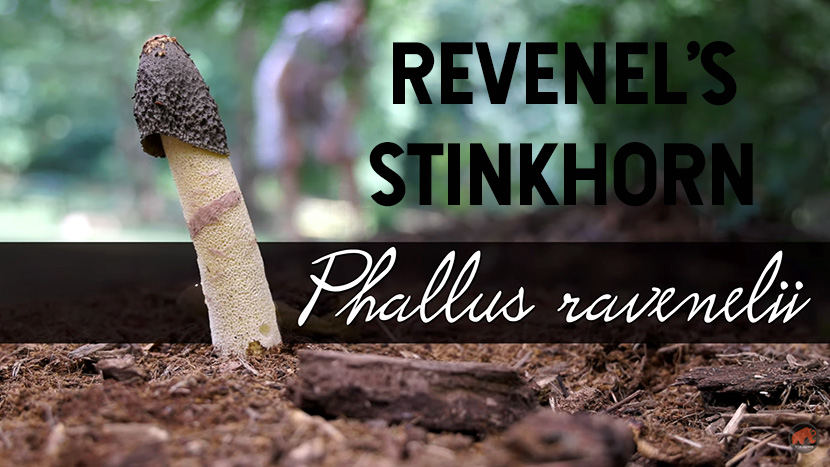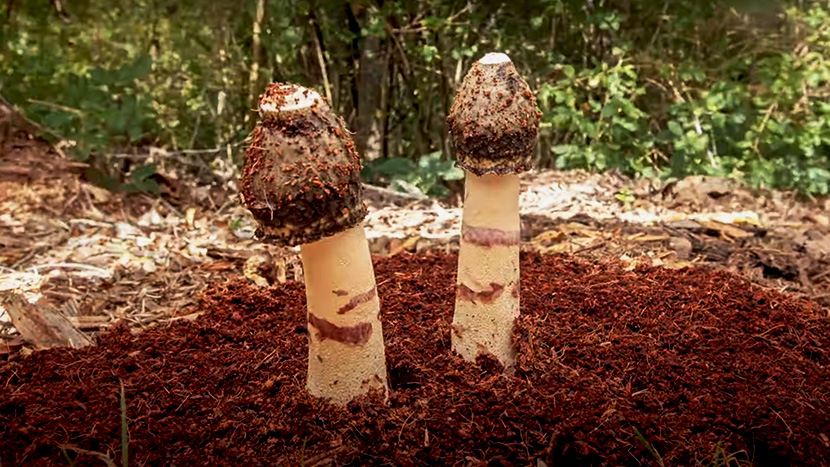Eating Stinkhorn Mushrooms?!

You are out on a lovely summer walk through the woods, enjoying the fresh breeze and the smell of late blooming flowers, when suddenly something catches your attention. There’s a new smell, an unpleasant smell. You do what any curious adventurer does, and follow your nose until you see it. There it is, sticking out of the ground. It is a mushroom, but not like any other you have spotted today. It is oddly shaped, covered in flies, impressively phallic, and well, very stinky. You have found a stinkhorn mushroom.
What is a Stinkhorn Mushroom?
Stinkhorn mushrooms make up the family of fungi called Phallaceae. There are currently 21 genera and 77 species described in the stinkhorn family. Their common name comes from the fact that they all smell pretty terrible – like either dung or rotting meat, or a bit of both. Their scientific name originates from the families tendency to have a quite phallic appearance.
There are many really interesting looking species in this family, but some of the more well known ones are:
The common stinkhorn, Phallus impudicus – which is the most common in Europe,
Revenel’s stinkhorn, Phallus ravenelii – which is the most common in the Eastern USA.
Fun Facts About the Stinkhorn Mushroom
Stinkhorn mushrooms are really strong!
A study showed that they can push up with a force of 1.33 kilonewtons /m squared! Meaning just 3 of them could live 400 pounds!
Legend has it that these mushrooms would be used in love potions and as an aphrodisiac. You can read on to see why this doesn’t really seem to be true.
They belong to a group of mushrooms called gasteromycetes or sequestrate fungi because they do not release their spores into the air. Instead, they rely on animals to disperse them, much like how flowers depend on animals for pollination. Interestingly enough, this last fact is actually why they have evolved to be so stinky!
Why Does Stinkhorn Stink So Badly?
The smell of this mushroom comes from the top cover of the mushroom, which is called the gleba. The Gleba is made up of mucus and the fungi’s reproductive spores. The mucus gives off the less-than-lovely smell in order to attract flies, which are the main mode of transport for the fungi’s spores!
Flies are attracted to the mushroom, thinking it is feces or a dead animal, consume the spores, and subsequently deposit the spores around the forest. Basically, the stink that is repulsive to us is just the right one to attract flies; in turn helping this fungi to reach new habitats.
Can You Eat Stinkhorn?
The short answer is yes, you can eat stinkhorn. But the real question is how can you eat stinkhorn, and do you really want to?
All mushrooms in the stinkhorn family are considered non-toxic. However, once they are mature mushrooms the smell is too repulsive for most people to even give it a shot.
However, there is a way you can eat the stinkhorn mushroom, and many would even consider it a useful culinary item for things like salads, soups, to put in sausage, and more.
You see, the stinkhorn mushroom grows in a very interesting way. Before sprouting up out of the ground into a mature mushroom, it grows in a small ball, which is often colloquially referred to as a Witch’s Egg. This witches egg does not have the potent smell of a mature mushroom, and the future stem is even said to taste like a radish or a nut at this stage.
According to Rob though, the rest of the egg is not particularly tasty:
Is Stinkhorn Medicinal?
Though there is a lot of folklore around this fungus, and still a lot that we don’t know, it does not seem like a very good candidate for medicinal use.
One study we found showed that stinkhorn can help reduce blood clots by reducing the aggregation of platelets. Though this seems promising, if you ask us, there are other great candidates for positive blood thinning properties, like chaga.
The stinkhorn was also supposedly a cure for gout in the medieval ages, but there doesn’t seem to be MUCH literature on the matter.
Last, there have been studies showing potential negative impacts of consuming stinkhorn. Studies in-vitro (meaning in the lab in controlled conditions) using compounds from this mushroom showed the potential to damage DNA and male fertility. This result kind of goes against the lore around this mushroom as a love potion.

In Conclusion
The stinkhorn mushroom family is a fascinating group of fungi that have evolved their terrible smell to help attract flies to spread their spores into new areas. In terms of edibility, you can eat stinkhorn mushroom by digging up and eating the witch’s eggs but we wouldn’t list these as the top mushrooms to forage for meals. Additionally, they do not seem to be particularly useful for medicinal purposes, especially when there are other great medicinal mushrooms that we do know more about. Either way, we encourage you to head out this summer and see if you can find these smelly mushrooms in your woods!

